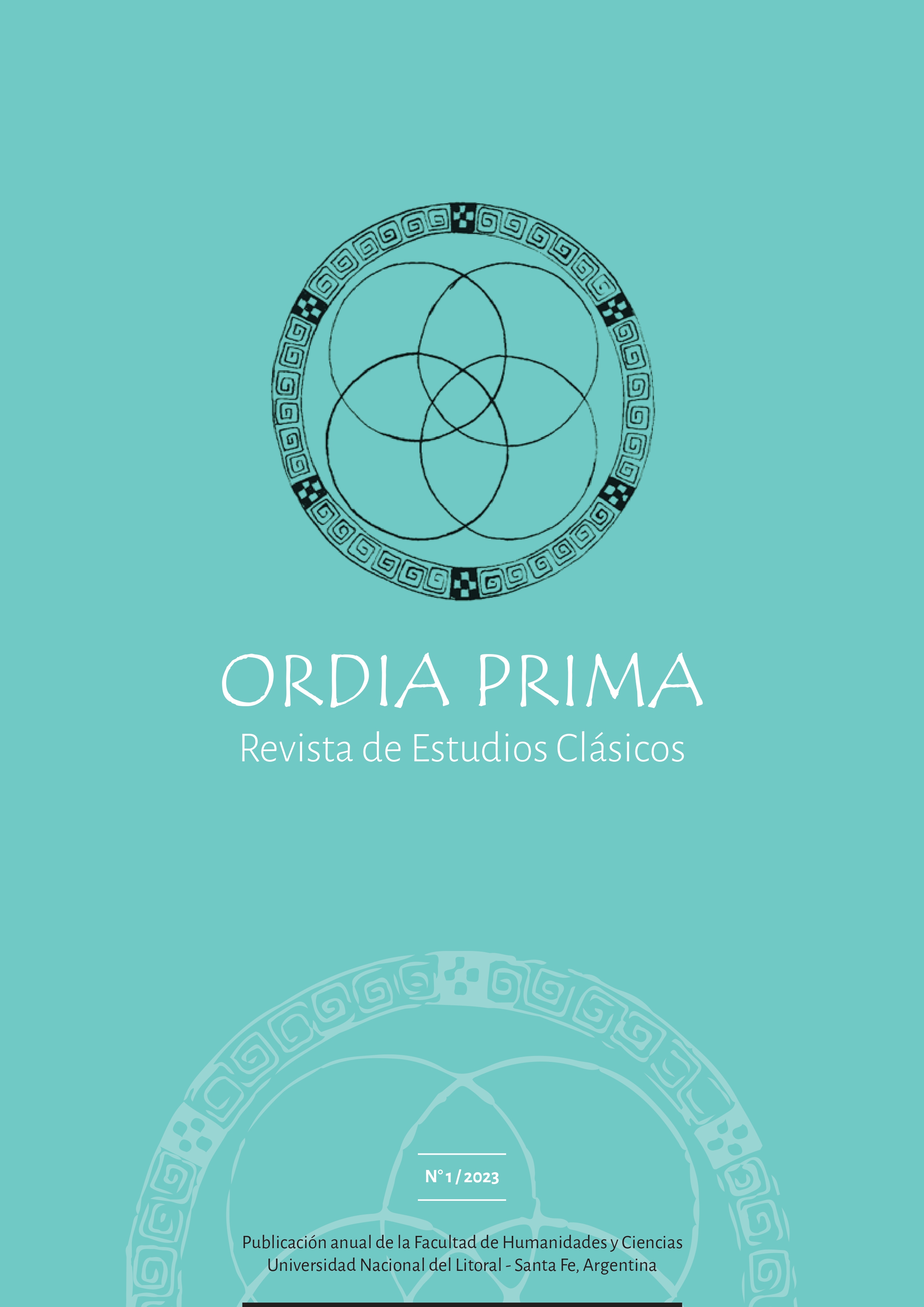La retórica del mosquito: los τόποι del τόπος de la fábula en Aquiles Tacio
DOI:
https://doi.org/10.14409/op.2023.1.e0009Keywords:
fable, topos, novel, Achilles TatiusAbstract
The τόποι as «places» of argumentation represent a constant of Greek rhetorical education, from sophistical teachings in Athens to the schools of the Empire. In the fictional narrative, these τόποι become strategies for the original experimentation of the traditional knowledge of paideia. In this work, we will address a passage from Aquiles Tacio's novel focused on the verbal competition between slaves around the onomastic game κώνωψ/Κώνωψ, «gnat/Gnat» (2.20–22). In this passage, the progymnasmatic exercise of the fable (μῦθος) is organized in an agon that involves, not only diverse literary genres, but also other complex exercises, such as encomion and invective, confirmation and refutation, thesis and hypothesis, creating levels of overlapping and novel readings as unique τόπος of the literate culture.
References
Bádenas de la Peña, Pedro y López Facal, Javier (1985). Fábulas de Esopo. Vida de Esopo. Fábulas de Babrio. Gredos.
Bernabé Pajares, Alberto (1978). Himnos homéricos. La batracomiomaquia. Gredos.
Bompaire, Jacques (1958). Lucien écrivain. Imitation et création. E. de Boccard.
Chew, Kathryn (2014). Achilles Tatius, Sophistic Master of Novelistic Conventions. En Cueva, Edmund and Byrne, Shannon (Eds.). A Companion to the Ancient Novel (pp. 62–75). Wiley–Blackwell.
Cribiore, Raffaella (2001). Gymnastics of the Mind: Greek Education in Hellenistic and Roman Egypt. Princeton University Press.
De La Fuente, Jorge Marcos (2004). El insecto como tema retórico y poético. Minerva 17, 85–102.
Delhay, Corinne (1990). Achille Tatius fabuliste? Pallas 36, 117–131.
Fernández Delgado, José Antonio (2006). Enseñar fabulando en Grecia y Roma: los testimonios papiráceos. Minerva 19, 29–52.
Gibbs, Laura (2002). Aesop’s Fables. Oxford University Press.
Gomez, Pilar y Mestre, Francesca (2006). Luciano y la tradición de la mosca. En Valverde Sánchez, Mariano, Calderón Dorda, Esteban y Morales Ortiz, Alicia (Eds.). Koinòs lógos: homenaje al profesor José García López (pp. 353–364). Servicio de Publicaciones de la Universidad de Murcia.
González Equihua, Rodolfo (2014). Heliodoro de Émesa y los Ejercicios preparatorios de Elio Teón. Nova Tellvs 31.2, 147–158.
Guzmán Hermida, Juan Manuel (1979). Isócrates. Discursos I. Gredos.
Hausrath, August und Hunger, Herbert (1959–1970). Corpus fabularum Aesopicarum I–II. Teubner.
Henry, Rene (1974). Photius. Bibliothèque VII. Les Belles Lettres.
Holwerda, Douwe (1977). Prolegomena de comoedia. Scholia in Acharnenses, Equites, Nubes. Bouma.
Jufresa, Montserrat, Mestre, Francesca y Gómez, Pilar (2000). Luciano. Obras III, C.S.I.C.
Kennedy, George (2003). Progymnasmata. Greek textbooks of prose composition and rhetoric. Society of Biblical Literature.
Larue Van Hook, George (1945). Isócrates III. Harvard University Press.
Macía Aparicio, Luis (2007). Aristófanes. Comedias II. Gredos.
Marzi, Mario (1996). Isocrate. Opere. Vol. I. Classici U.T.E.T.
Mestre, Francesca (2016). Exercices scolaires: un moyen de réfléchir sans émotion et sans danger. Rursus 9, 1–12.
O’Sullivan, James (1980). A Lexicon to Achilles Tatius. Walter de Gruyter.
Parreu Alasà, Francisco (2001). Diodoro de Sicilia. Biblioteca Histórica. Libros I–III. Gredos.
Penella, Robert (2011). The Progymnasmata in Imperial Greek Education. Classical World 105.1, 77–90.
Pernot, Laurent (1986). Lieu et lieu commun dans la rhétorique Antique. BAGB 3, 253–284.
——— (1993). La rhetorique de l’eloge dans le monde greco–romain. Institut d’Etudes Augustiniennes.
Rabe, Hugo (1896). Anonymi in Artem Rhetoricam commentaria. Reimer.
Reche Martínez, María Dolores (1991). Teón. Hermógenes. Aftonio. Ejercicios de Retórica. Gredos.
Rodríguez Adrados, Francisco (1979). Historia de la fábula grecolatina I. Editorial de la Universidad Complutense.
——— (1985). Historia de la fábula grecolatina II. Editorial de la Universidad Complutense.
Ruiz Montero, Consuelo (2014). La Vida de Esopo (rec. G): niveles de educación y contexto retórico. En Mestre, Francesca y Gómez, Pilar (Eds.), Three Centuries of Greek Culture under the Roman Empire. Homo Romanus Graeca Oratione (pp. 61–81). Universitat de Barcelona.
Suleiman, Susan (1977). Le récit exemplaire. Parabole, fable, roman à thèse. Poétique 32, 468–479.
Van Dijk, Gert–Jan (1996). The Function of Fables in Graeco–Roman Romance. Mnemosyne 49, 513–541.
——— (1997). ΑΙΝΟΙ ΛΟΓΟΙ ΜΥΘΟΙ. Fables in Archaic, Classical, and Hellenistic Greek Literature. Brill.
Vilborg, Ebbe (1955). Achilles Tatius. Leucippe and Clitophon. Almqvist & Wiksell.
——— (1962). Achilles Tatius. Leucippe and Clitophon. A Commentary. Elanders Boktryckeri Aktiebolag.
Webb, Ruth (2001). The Progymnasmata as Practice. In Too, Yun Lee (Ed.), Education in Greek and Roman Antiquity (pp. 289–316). Brill.
Whitmarsh, Tim and Morales, Helen (2001). Achilles Tatius. Leucippe and Clitophon. Oxford University Press.
Published
How to Cite
Issue
Section
License
Copyright (c) 2023 Ivana Chialva

This work is licensed under a Creative Commons Attribution-NonCommercial-ShareAlike 4.0 International License.



